I’m writing from the Business Lounge at Paro airport, about to fly out to Amritsar in northern India via Delhi. I’m a little behind in my reportage because for 24 hours from Saturday morning to Sunday morning (yesterday) someone or something was blocking access to my website! Webman Rob in Hobart reported everything hunky-dory back at the ranch so we presumed the otherwise warm and fuzzy Bhutanese government took exception to something I posted online and put up some kind of geoblock. I didn’t say anything too nasty about the Royal Family, although I did make a leetle joke about the fourth King’s wives. Could it have been all the phallus stuff? I mean, they’re not shy about it but I admit I was a little facetious on the subject. But whatever it was, all is forgiven because as of this Monday morning I am able to play with and post to my website again.

At one stage I thought perhaps I wasn’t being spiritual enough for their liking and that I should be putting in more temples and monasteries and suchlike, but although there’s a lot of splendour and gorgeousness to be seen and quite a bit of historical interest, there is just so much Buddhist esoterica a rationalist atheist like me can take. But I did sit under a Bodhi tree with Karma, seeking enlightenment a la Buddha. Don’t know if I got it, but it was a nice place to sit after a steep walk up the path to the Madman’s temple.

Check out this place, the ‘Palace of Great Happiness’, built in 1637. From memory, it was the old capital of Bhutan, till geographic reality forced a move to Paro, the only place an international airport could be built. It’s still the site of all coronations and royal weddings. No photos allowed inside the temple, but there were giant paintings of the life of Buddha around the walls and I did enjoy Karma’s storytelling about this great philosopher, albeit one from so long ago (8th century BC) that most of the biography has been embellished and overlaid with supernatural legend.

I went for a walk along this riverbed while waiting for the palace to open. It was my idea. The Bhutanese idea of a walk is either something punishing you do up a hill to get to a temple, or something poor folks HAVE to do every day for work. Karma did say there was no point making a nice river walk here because the spring floods would just wash everything away.

Here’s a map of Bhutan, crappily scanned by me from a folding brochure. See Punakha in the northeast? That’s where the POGH was, and it was the main reason for our going there. My tour was in the relatively small triangle Paro-Thimpu-Punakha. Not that the rest of the country is closed; it was a matter of time limitation and the slow pace of travel. The speed limit on the highway is 50kph, but the police will allow up to 60kph. It felt faster than that, although it did take a long time getting to our destinations despite the short distances. Paro to Punakha is 130km but it took us 4 – 5 hours.

There is really only the one main road In Bhutan. It is a two-laned highway, but it’s adequate for the size of the population – about 800,000 – and driving around is generally a pleasure. From Thimpu to Punakha we drove up over a mountain ridge, the top of which was a spot called Drochula at an altitude of 3100 metres. That’s me enjoying the fabulous view towards the Bhutanese Himalayas in the pic at the top of the post.
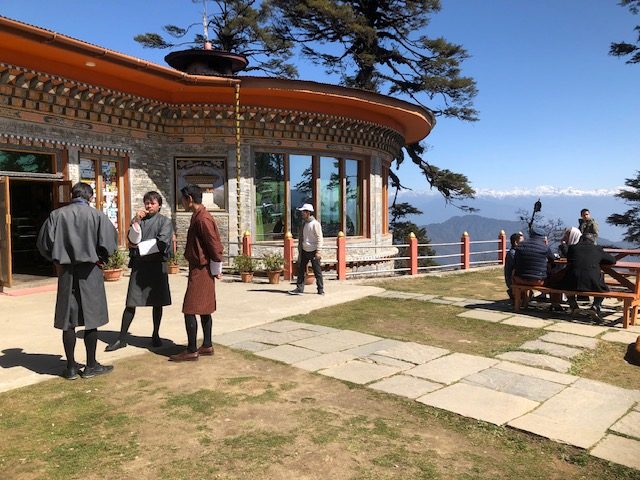
This was probably the trip highlight. The sublimely perfect weather might have had something to do with it.

The stupas you can see were ordered built by one of the Queens to commemorate the loss of Bhutanese life in a small war that happened in 2003 when Assamese separatists, demanding independence from India, set up camp on Bhutanese soil and terrorised the local people. There were only a few soldiers killed, and thanks to India they were seen off. (Bhutan has very good relations with India, which has military bases here and trains local soldiers. Most tourists are Indians. Or Vietnamese. But I did see a big party of Germans today at lunch in Paro. A few Aussies, a few Americans.)

On the way back, the following day, the weather had changed.
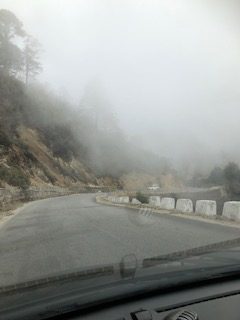
You can see how good the roads are. Very different from Nepal (which has a much bigger population – 30 million) and there’s nowhere near as much rubbish. There are signs everywhere urging people not to litter, not to do drugs, to drive patiently, to preserve the environment…and it does seem to be working.


We went to a Natural History museum too, which was very good, and to a wildlife reserve to see, among other critters, the national animal of Bhutan – the Takin. He’s a short stocky antelope who looks a bit like a big fat goat. He didn’t do anything interesting so I left his photo out.
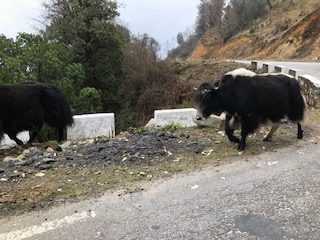
Cows are not sacred but they wander the roads at will. They are bred for dairy and all belong to someone. We saw yaks wandering the roads too. Not sure about this lot, but yaks have been traditionally herded by nomadic peoples who live mostly in the east.


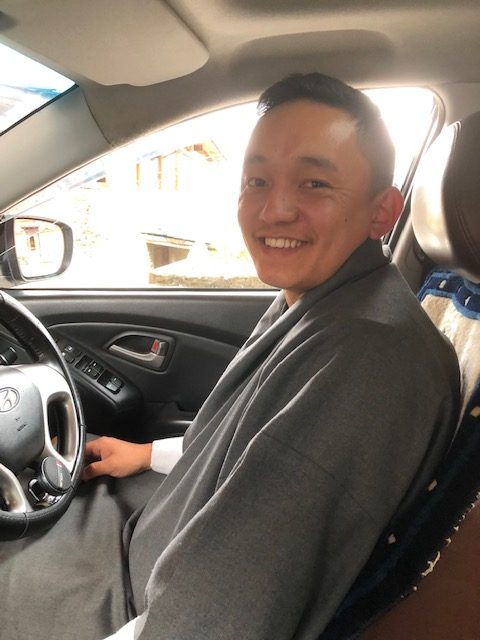
Because we spent so much time on the roads I learnt a lot about how they manage cars and roads. Most cars are imported from India, and attract a 50% import duty, rising according to the amount of horsepower. Cars from other western countries attract a 100% duty, also rising according to horsepower. Indian-built trucks used by farmers attract no duty. It’s a government incentive to keep enough people working the land.
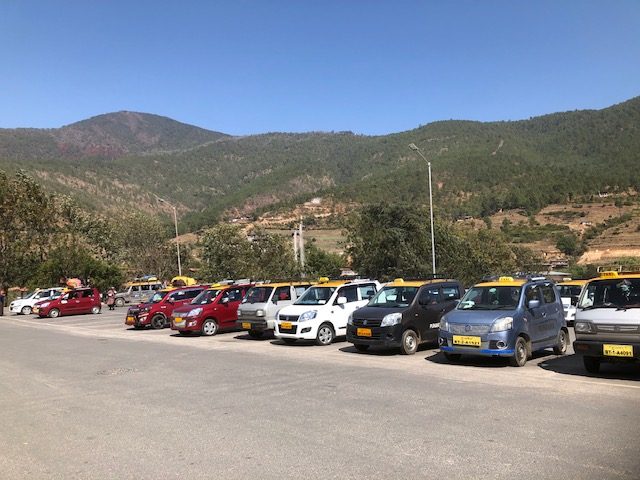
There are four kinds of number plate prefixes: BTs are the taxis – the lowliest vehicle, BP for a private car like ours (belonging to the travel company), BG for a government car, and Bhutan for the Royal Couple, of which there are only two such plates in the whole country. They actually passed us on the highway between Thimpu and Paro! Cars stop for them; they don’t just give way. When we stopped, I barely had time to ask why before the 2 shiny dark SUVs cruised by, and I had no time to whip out my camera phone.

The Bhutanese seem to be doing so many things wisely for a country that was just nomadic herders, peasant farmers and monks a few decades ago. Here’s a zebra crossing in Thimpu. The boys chuckled a bit about how it took the locals a while to get used to it, but it’s such a change from the situation in most undeveloped countries, like Nepal for instance, or even big powers like China and Russia, where you just have to take your life in your hands, step boldly onto the road and trust that the traffic will not plough into you. I think I mentioned that I had to be escorted across the road and back outside the Shangri La in Kathmandu because there were no traffic lights or pedestrian crossings at all, even in a city of many millions.
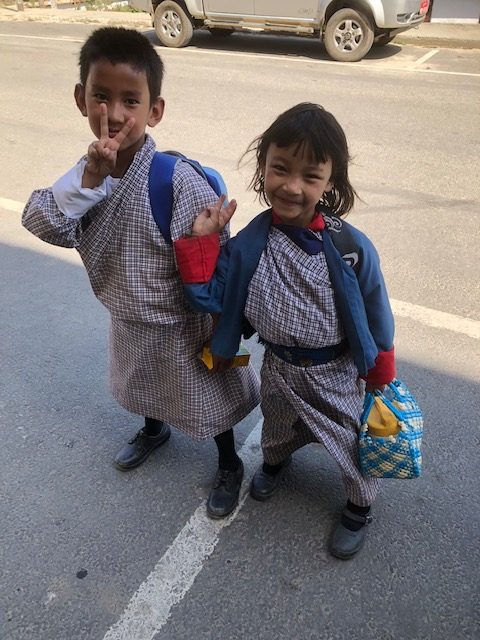
This little girl asked me for money! I truthfully said I didn’t have any on me, having left my stash at the hotel in Punakha before our excursion. Wongchuk was off buying me two cans of local Druk lager, which is rather good, and cheap at 80 ngultrum a can from local shops. That’s just over one American dollar. You will be charged 4 or 5 times as much in a hotel restaurant or mini-bar. I paid Wongchuk back, of course. The Bhutanese ngultrum is worth the same as an Indian rupee and pegged to it.
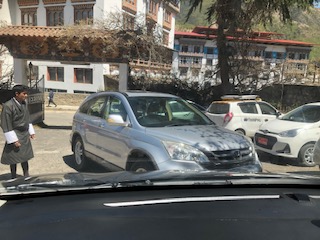
Speaking of money, one thing I wish the travel company had told me in advance was that you get a much better exchange rate on $US dollars if you change high-denomination notes, ie 68 to the dollar as opposed to 61. It strikes me that’s a VERY useful thing to know, yet I haven’t seen it mentioned anywhere in the information sources or online.
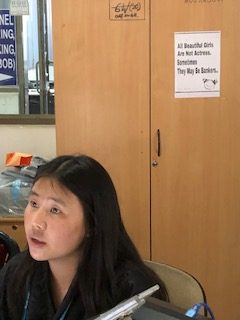
I’ve got a little more to tell before I move on to India but had better post now before my 45 minutes of free wifi here at Delhi airport runs out. It ran out.
